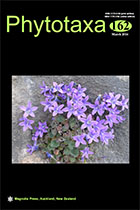Abstract
Based on our detailed observations in the field, completed with herbarium material of representatives of Hydrangea section Cornidia in southeastern Mexico and Central America, we found that Hydrangea steyermarkii Standley, in contrast to what has been assumed up to now, is restricted to the Tacaná Volcano on the border of Mexico and Guatemala. The majority of the specimens with reddish or whitish indument on their branches in South East Mexico and Central America, belonging to this nearly exclusively Neotropical Hydrangea clade, had been identified as such, but the characters of these collections do not coincide with the single type specimen of H. steyermarkii, neither with other individuals of this species growing in the type locality area. In fact, nearly all specimens of Mesoamerica that had been identified as this species belong to a new species with a relatively wide distribution, which we describe here. This new species is illustrated and compared with H. steyermarkii, of which we also provide an amended description and illustrations. Finally, on the basis of these two species we document previously suggested dioecism in this plant group, which not only has consequences for systematics and nomenclature in this clade, but also for conservation.

